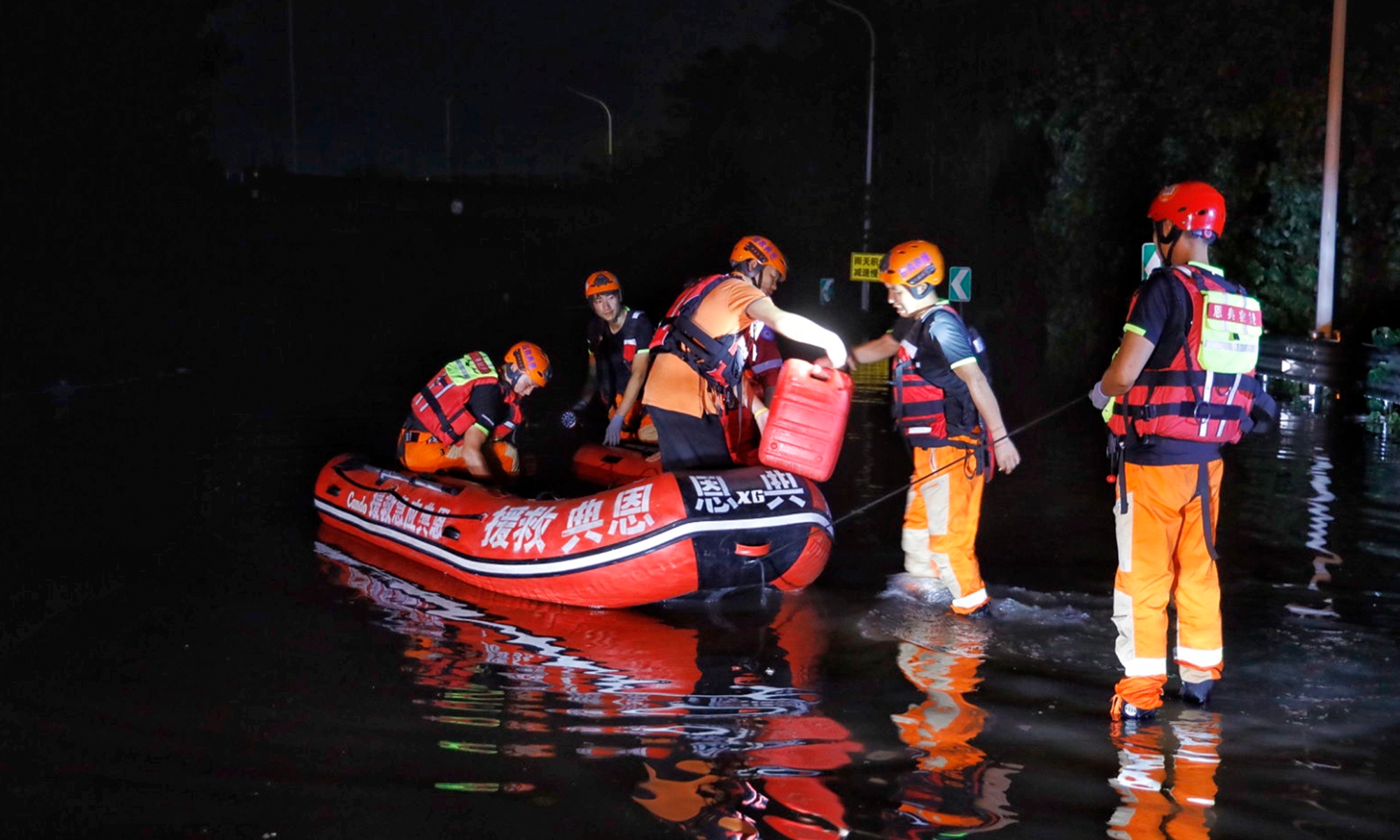Downpours in Henan threaten more regions as evacuation, rescue efforts accelerate

Rescue workers put relief goods into one raft boat. Photo: Li Hao/GT
While storm-ravaged Central China city Zhengzhou downgraded its emergency response level on Thursday after days of rainfall subsided to allow the provincial city of Central China’s Henan to clean up debris and mud, heavy rain continued to pound other parts of the province, with the death toll climbing to 33 and eight still missing as of press time on Thursday.
The floods have affected more than three million across the province and forced 37,600 to be evacuated. More than 215,200 hectares of crops have been damaged, causing a direct economic loss of about 1.22 billion yuan ($ 188.6 million). Provincial city Zhengzhou is still struggling to resume full electricity supplies, and some people are still stranded due to sporadic inundations, while the rainfall late Wednesday worsened the situation somewhat.
However, the rain has finally stopped and did not look like returning on Thursday. The pumping of inundated lowlands, clean-up of debris, and restoration of collapsed roads and facilities are underway.
Three out of eight damaged substations have been fixed and 3,600 staffers are working to restore power supplies for the urban area. Meanwhile, heavy rain began to batter the neighboring cities and rural areas, and rescue forces concentrated around Zhengzhou were quickly drafted into other regions in response to the new situation.
Due to impeded power and communications in disaster-stricken areas, netziens relay unfamiliar names of counties, townships and villages online for frontline rescuers, many of whom have been working around the clock, to consider as their next stop, while the Global Times reporters at the scene found that the smaller cities appeared to be better prepared.
Rescue efforts accelerate
Downpours flooded Anyang, a northern Henan city on Thursday morning when the situation in the city was reported to be severe and the People’s Armed Police Force was quickly deployed to the city for rescue operations.
Floodwater in the urban area receded in midday and the downstream Jianshan village was soaked in meter-deep water, but it receded quickly.
An elderly villager told the Global Times that floods of this scale had not happened in decades. Drainage ditches were unable to handle such raging torrents and the corn fields have been totally ruined.
A China Mobile employee, who is checking a base station, told the Global Times on Thursday that the checks, repairs and replacement of damaged base stations would take a very short time. As long as the water recedes and electricity is restored, communications will return.
The Global Times learned from frontline rescue forces that flood response has been enhanced and the situation in disaster-stricken areas has been quickly relieved. The weather offered some respite, with rain levels going down since Thursday noon.
Anyang issued three red alerts in six hours late on Wednesday, ordering people to stay at home and suspending all public transportation.
Mountainous Hebi city recorded the highest 24-hour rainfall in Henan at 675.5mm from Wednesday to Thursday, and in some townships, the water even inundated the second floors of buildings.
An aerial assault brigade of the People’s Liberation Army (PLA) Central Theater Command is heading to Hebi and aid Qixian county, which is located under a mountain and faces high risks of flash floods and landslides.
The city of Xinxiang, north of Zhengzhou on the other side of the Yellow River, continued to issue a red alert on Thursday morning and accordingly ordered all residents to stay at home.
The one-hour precipitation record from Wednesday to Thursday was registered in Xinxiang at 149.9mm, equal to the daily rainfall of Cologne’s record rainstorm in mid-July.
The severe situation in Zhengzhou rang alarm bells for small cities, and thanks to weather forecasts, evacuation and relocation work was accelerated before the heaviest downpours arrived.
With PLA Central Theater Command and Armed Police units taking charge of rescue and flood control efforts, and civil assistance continuously pouring in, disaster response and relief work has become more organized and efficient.
A Xinxiang urban resident surnamed Liu told the Global Times via short messages that some lower residential buildings in his compound had suffered blackouts, but people stayed at home as alerted and had prepared food and water beforehand.
“First-floor residents were less fortunate as they suffered bigger losses of property, but at least we are all safe here, waiting for the water to recede,” Liu said.
Rural edge
Liu expressed concerns over the rural areas, which have fewer high buildings for people to take shelter from rising floodwater.
Due to blackouts and weak signals, it has been difficult to make contact with stranded people.
Amid concerns over small cities and rural areas, experts noted that these cities are better prepared after seeing how hazardous the downpours could be for a metropolis like Zhengzhou, and rural areas have both disadvantages and an edge in responding to floods.
Xue Lan, a professor from the School of Public Policy and Management at Tsinghua University in Beijing, told the Global Times on Thursday that running water, power and communications infrastructures in villages are less reliable than in cities and easily fail when being confronted with floods of this scale, which is why people see so much information on an entire village losing contact.
But Xue pointed out that the vast crop fields in villages can hold large amounts of water, giving them an edge in battling floods.
While the crops may fail, fields can be turned into reservoirs and reduce the risks for houses and residents, Xue said.
Xue also noted flash floods in mountainous regions are another threat that rural areas face.
Efficient forecasts and early warning mechanism, quick evacuation and close monitoring of water bodies are required to minimize damages and casualties in the future, observers said.
How to be better prepared
Rescuers aren’t breathing a sigh of relief just yet, as the rainfall has now moved northward to Shanxi and Hebei provinces. Though much weaker, it still carries the risk of generating flash floods.
Despite the unprecedented natural disaster could overwhelm almost any city's drainage system, it has also prompted debate on how to better prepare for risks.
The biggest lesson learned this time is that not enough attention was paid to rainstorm red alerts issued by weather forecast departments, urban management experts said, saying Zhengzhou had sent red alerts for three consecutive days, but people went to work, school and shopping as usual on Tuesday when the heaviest downpour came.
“Authorities and ordinary people should raise their awareness of risks amid challenges posed by climate change. As extreme weather becomes more frequent, we should prepare for ‘disaster in 1,000 years’,” Xue said, citing food and water storage ahead of hazardous weather and timely relocation of people in times of such downpours as examples.
Photos
Related Stories
- Measures taken to ensure supply of agricultural products in Zhengzhou after heavy rainfall
- Civilian heroes show perseverance of Chinese people fighting floods
- Chinese health authority dispatches medical response group to flood-hit Henan
- 33 dead, 8 missing in China's flood-hit Henan
- Survivor recounts experience in Zhengzhou Metro flood
Copyright © 2021 People's Daily Online. All Rights Reserved.










